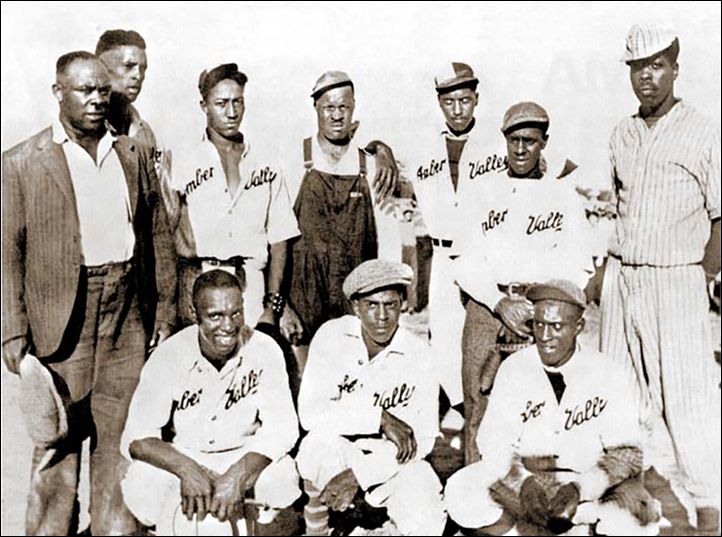
The Amber Valley Baseball Team, Undated (Photo from Glenbow Museum Archives)
Kneeling, left to right: Booker “Book” Edwards, Arthur “Man” Saunders, Kenneth “Kenny” Edwards Standing, left to right: Clifford “Doc” Brown, Everett “Forty” Medlock, Horace “TC” Hinton, JB “Big J”, Alvin Brown, Alonzo “Moose” Edwards, Oswald “Peepsight” Lipscombe (player identification by Black Pioneer Descendants’ Society)
In the early 1900s a group of black settlers from Oklahoma trekked to Alberta to begin new lives in a small community north of Edmonton that later would become known as Amber Valley. The town became well known in later years through the play of its baseball team.
July 3, 1997 Plains Folk / Prairie Prejudice
Tom Isern, Professor of History North Dakota State University
The plains of North America became home to many dispossessed peoples of the world, among them some refugees from within our own country. During the 1870s, thousands of Exodusters, former slaves, trekked west to Kansas and Oklahoma, seeking to escape the racism endemic to the Old South. Unfortunately, they were not necessarily well received in their new western homes, either. Kansas, after all, was the state whose segregated schools eventually led to the Brown v. Board of Education case.
Euro-Americans on the northern plains are liable to make smug observations about their lack of racial difficulties. What this generally means, though, is that they have had very few blacks among them, too few to arouse the animosity of white neighbors.
Now a new book by R. Bruce Shepard tells the sad and remarkable story of American blacks on the Canadian prairies, the so-called Last Best West. The book, published by Umbrella Press of Toronto, is called "Deemed Unsuitable" the title a quotation from an order-in-council by the Canadian government in 1911.
On August 12 of that year the Canadian government said, "For a period of one year from and after the date hereof the landing in Canada shall be and the same is prohibited of any immigrants belonging to the Negro race, which race is deemed unsuitable to the climate and requirements of Canada."
Here's the story. Black Exodusters who came to Oklahoma joined freed blacks who had lived among the Indians to form a substantial minority in the Oklahoma and Indian territories. There were a number of all-black towns in the territories, among them Langston, eventual home of Oklahoma's black agricultural college. The black citizens considered Oklahoma Territory a congenial place under Republican territorial administration.
Then came Oklahoma statehood in 1907, and with it Democratic control of the new state. Oklahoma swiftly enacted Jim Crow laws that is, laws providing for systematic discrimination against blacks. It happened that at this same time Canada was in the midst of a concerted campaign to recruit settlers from the United States to the Canadian prairies. Blacks in Oklahoma not the intended audience! read the Canadian promotional literature. A few brave pioneers, like Tony Payne of Canadian County, headed north as early as 1908.
Many more followed in 1911, the total exceeding a thousand. Black homesteading communities crystallized at Maidstone, Saskatchewan, and at Amber Valley, Wildwood, Lobstick Lake and Breton, Alberta.
Reaction was rapid and negative. The Edmonton Board of Trade said, "Those negroes who have been here some time have had a square deal and been treated as whites, but if you get a few thousand more in, conditions would be much changed." The United Farmers of Alberta said, more explicitly, "We consider negroes undesirable as fellow citizens of this Province." And thus the Canadian government, while continuing to recruit settlers from the United States, Britain and even eastern Europe, was led to exclude American blacks on the basis of race.
Few black homesteaders remain where they put their hands to the plow in the black homesteading communities of the plains states and the prairie provinces. Often this is explained by the lack of capital or agricultural expertise among them. Bruce Shepard reminds us that another factor, a disquieting one, was at work among plains folk. It's a story to be read and remembered.
NDSU Agriculture Communication
Departmental Editor: Barry Brissman
(701) 231-7866
Source:
Isern: (701) 231-8339
Grow, Stewart. "The Blacks of Amber Valley: Negro Pioneering in Northern Alberta." Canadian Ethnic Studies 6, nos. 1-2 (1974): 17-38.
